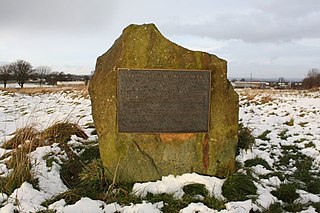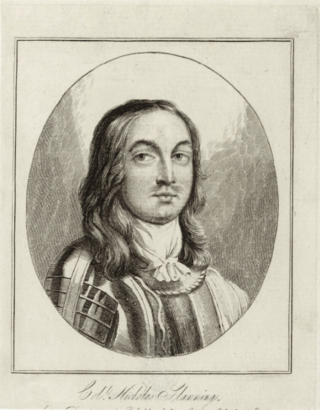The Battle of Lostwithiel took place over a 13-day period from 21 August to 2 September 1644, around the town of Lostwithiel and along the River Fowey valley in Cornwall during the First English Civil War. A Royalist army led by Charles I of England defeated a Parliamentarian force commanded by the Earl of Essex.

The Battle of Roundway Down was fought on 13 July 1643 at Roundway Down near Devizes, in Wiltshire during the First English Civil War. Despite being outnumbered and exhausted after riding overnight from Oxford, a Royalist cavalry force under Lord Wilmot won a crushing victory over the Parliamentarian Army of the West under Sir William Waller.

The First English Civil War battle of Lansdowne, or Lansdown, was fought on 5 July 1643, at Lansdowne Hill, near Bath, Somerset, England. Although the Royalists under Lord Hopton forced the Parliamentarians under Sir William Waller to retreat from their hilltop position, they suffered so many casualties themselves and were left so disordered and short of ammunition that an injured Hopton was forced to retire.

The battle of Hopton Heath was a part of the First English Civil War, fought on Sunday 19 March 1643 between Parliamentarian forces led by Sir John Gell and Sir William Brereton and a Royalist force under Spencer Compton, 2nd Earl of Northampton.

Sir Bevil Grenville was an English landowner and soldier who sat as a Member of Parliament for various constituencies between 1620 and 1642, although during those years there were few parliamentary sessions. When the First English Civil War broke out in August 1642, he joined the Royalists and played a leading role in their early campaigns in the West Country. He was killed in action at the Battle of Lansdowne in 1643.

The Battle of Adwalton Moor occurred on 30 June 1643 at Adwalton, West Yorkshire, during the First English Civil War. In the battle, the Royalists loyal to King Charles led by the Earl of Newcastle soundly defeated the Parliamentarians commanded by Lord Fairfax.

The Battle of Cheriton of 29 March 1644 was an important Parliamentarian victory during the First English Civil War. Sir William Waller's "Army of the Southern Association" defeated a Royalist force jointly commanded by the Earl of Forth and Sir Ralph Hopton. Defeat ended Royalist hopes of retaking South East England and forced them onto the defensive for the rest of 1644.

Braddock is a village and civil parish in Cornwall, England, United Kingdom. The village is about seven miles west of Liskeard, and five miles south-east of Bodmin. The parish was called Broadoak until 1 April 2021.

Sir Bevil Grenville's Monument is a monument erected in 1720 on Lansdown Hill, then called Lansdowne Hill, in Charlcombe parish about 4 miles (6.4 km) north-west of the city of Bath, in Somerset, England. It was designated a Grade II* listed structure in 1956, and a scheduled monument in 1950.

St Winnow is a civil parish in Cornwall, England, United Kingdom. Its name may be connected with either that of Saint Winnoc or Saint Winwaloe. It has a population of 304, which had increased to 328 at the 2011 census. The church town is on the east bank of the River Fowey south of Lostwithiel. Part of the village of Lerryn lies within the parish as does the Chapel of St Nectan. The Redlake Meadows & Hoggs Moor, a Site of Special Scientific Interest is also in the parish.

James Compton, 3rd Earl of Northampton FRS, was an English peer, politician and author, who fought for the Royalists during the First English Civil War.
Events from the year 1643 in England. This is the second year of the First English Civil War, fought between Roundheads (Parliamentarians) and Cavaliers.

Sir Nicholas Slanning was a soldier and landowner from Devon who sat in the House of Commons from 1640 to 1642. He served in the Royalist army during the First English Civil War and was mortally wounded at Bristol on 26 July 1643.

The Battle of Sourton Down took place on 25 April 1643, near Sourton, in Devon, during the First English Civil War. A Parliamentarian force under James Chudleigh defeated a Royalist army under Sir Ralph Hopton. Casualties on both sides were light, and the result had little impact on the strategic position in the West Country.

Cornwall played a significant role in the English Civil War, being a Royalist enclave in the generally Parliamentarian south-west.

The Battle of Stratton, also known as the Battle of Stamford Hill, took place on 16 May 1643, at Stratton in Cornwall, during the First English Civil War. In the battle the Royalists destroyed Parliament's field army in Devon and Cornwall.
Sir William Godolphin was an English soldier and politician who sat in the House of Commons in 1640. He fought for the Royalist cause in the English Civil War.

Colonel James Chudleigh was an English military officer, who served in the First English Civil War. Initially appointed to command the Parliamentarian garrison at Barnstaple, he showed considerable ability, and was quickly promoted.

The siege of Plymouth took place during the First English Civil War, when Royalist forces besieged Plymouth, in Devon, held by a Parliamentary garrison.

The siege of Exeter (1642) or First Siege of Exeter took place during the First English Civil War from late December 1642 to early January 1643 when Royalists led by Sir Ralph Hopton attempted to capture the port of Exeter from the Parliamentarians.

















